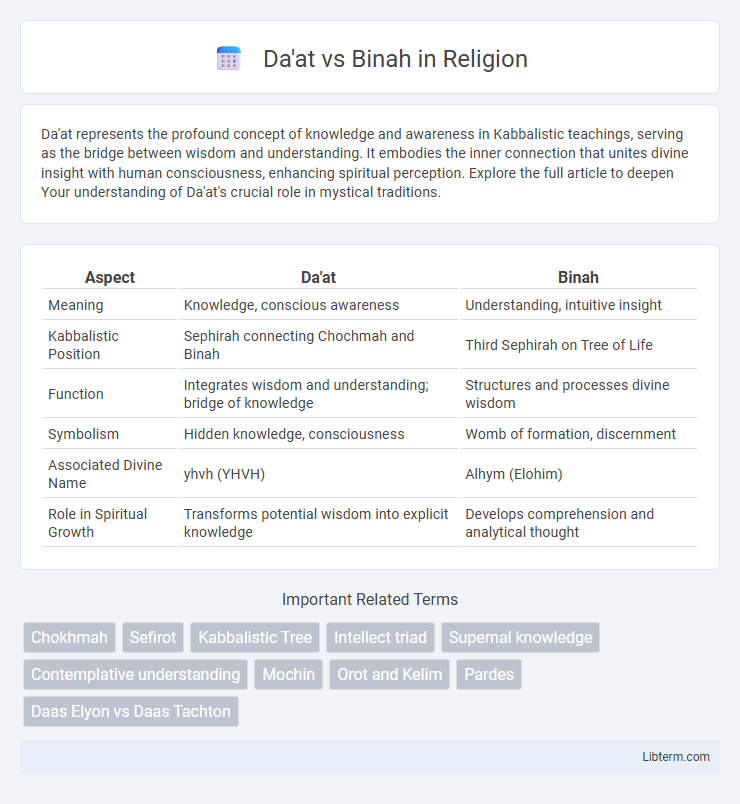Da'at represents the profound concept of knowledge and awareness in Kabbalistic teachings, serving as the bridge between wisdom and understanding. It embodies the inner connection that unites divine insight with human consciousness, enhancing spiritual perception. Explore the full article to deepen Your understanding of Da'at's crucial role in mystical traditions.
Table of Comparison
| Aspect | Da'at | Binah |
|---|---|---|
| Meaning | Knowledge, conscious awareness | Understanding, intuitive insight |
| Kabbalistic Position | Sephirah connecting Chochmah and Binah | Third Sephirah on Tree of Life |
| Function | Integrates wisdom and understanding; bridge of knowledge | Structures and processes divine wisdom |
| Symbolism | Hidden knowledge, consciousness | Womb of formation, discernment |
| Associated Divine Name | yhvh (YHVH) | Alhym (Elohim) |
| Role in Spiritual Growth | Transforms potential wisdom into explicit knowledge | Develops comprehension and analytical thought |
Introduction to Da'at and Binah
Da'at and Binah are integral sephirot in the Kabbalistic Tree of Life, with Da'at representing knowledge and Binah symbolizing understanding. Da'at functions as the bridge linking the intellectual faculties of Keter, Chokhmah, and Binah, serving as the channel through which divine knowledge manifests into conscious awareness. Binah, positioned as the third sephirah, embodies the intuitive process of comprehension and conceptualization, shaping and organizing wisdom into discernible patterns.
Defining Da'at: Knowledge in Kabbalah
Da'at in Kabbalah represents the mystical concept of knowledge as an internalized state, bridging the sefirah of Binah (understanding) and Chokhmah (wisdom) to enable conscious awareness and spiritual insight. Unlike Binah, which signifies intellectual comprehension and analytical processing, Da'at embodies the integration and realization of knowledge, turning abstract understanding into experiential wisdom. This unique role allows Da'at to act as the connective force that harmonizes cognitive faculties, facilitating deeper connection with the divine emanations within the Tree of Life.
Understanding Binah: The Power of Insight
Binah represents the divine understanding and intuitive insight essential for grasping complex spiritual concepts within Kabbalah. It functions as the analytical intelligence that processes and organizes knowledge, enabling deep comprehension beyond surface awareness. Da'at, often associated with knowledge itself, acts as the conduit through which Binah's insight becomes internalized and consciously accessible.
Historical Context of Da'at and Binah
Da'at and Binah are foundational concepts in Kabbalistic mysticism, representing distinct yet interconnected aspects of divine wisdom and understanding within the Tree of Life. Historically, Binah, often translated as "Understanding," is one of the upper sefirot associated with the process of intellectual comprehension and the formulation of divine ideas, while Da'at, meaning "Knowledge," acts as a concealed or integrative sefirah bridging Binah and Chokhmah (Wisdom). Ancient Kabbalistic texts emphasize Da'at's role as the internalization and realization of Binah's abstract insights, underscoring its historical significance as a dynamic interface that transforms conceptual understanding into conscious knowledge.
Symbolism in the Tree of Life
Da'at symbolizes the hidden knowledge and the bridge between the conscious and unconscious aspects of the Tree of Life, often visualized as the mysterious abyss that connects the upper triad to the lower sephirot. Binah represents understanding and the divine feminine intelligence, acting as the womb of creation and the source of form from which emanation flows. Together, Da'at and Binah embody the dynamic interplay between hidden wisdom and structured comprehension in Kabbalistic symbolism.
Da'at vs Binah: Core Differences
Da'at represents hidden or internalized knowledge in Kabbalah, acting as the bridge between the conscious intellect and subconscious understanding. Binah, on the other hand, signifies understanding and analytical processing, responsible for interpreting and organizing information within the sefirah framework. The core difference lies in Da'at's role as an integrative, often concealed knowledge center, while Binah functions as the explicit, structured comprehension of wisdom.
Practical Applications in Spiritual Practice
Da'at represents the internalization and manifestation of knowledge, enabling direct experiential awareness in spiritual practice. Binah serves as the analytical understanding and processing of divine wisdom, structuring insights into coherent frameworks. In practical application, Da'at facilitates intuitive connection and integration of spiritual truths, while Binah supports disciplined study and discernment necessary for deepening mystical comprehension.
Da'at and Binah in Jewish Mysticism
Da'at and Binah are crucial sephirot in Jewish Kabbalah, representing distinct aspects of divine cognition and understanding. Da'at, often called knowledge, acts as the hidden bridge connecting the intellect and the emotions, facilitating the internalization of wisdom from Binah, the sephirah of understanding and analysis. Binah processes raw information from Chokhmah, transforming it into structured insight, while Da'at grounds this understanding in conscious awareness, enabling practical application in spiritual development.
Integrating Da'at and Binah in Daily Life
Integrating Da'at and Binah in daily life involves harmonizing knowledge (Da'at) with understanding (Binah) to enhance decision-making and personal growth. Da'at, representing the conscious integration of information, complements Binah's analytical and interpretative processes, enabling deeper insights and emotional intelligence. Cultivating this balance fosters clarity, wisdom, and effective problem-solving in everyday experiences.
Conclusion: Harmonizing Knowledge and Understanding
Da'at and Binah represent complementary aspects of the cognitive process, where Da'at embodies the internalization of knowledge and Binah signifies deep understanding and analytical insight. Achieving a balance between Da'at's integration of information and Binah's comprehension enables a holistic approach to wisdom. This harmonization fosters enhanced decision-making and intellectual clarity by uniting factual awareness with meaningful interpretation.
Da'at Infographic

 libterm.com
libterm.com